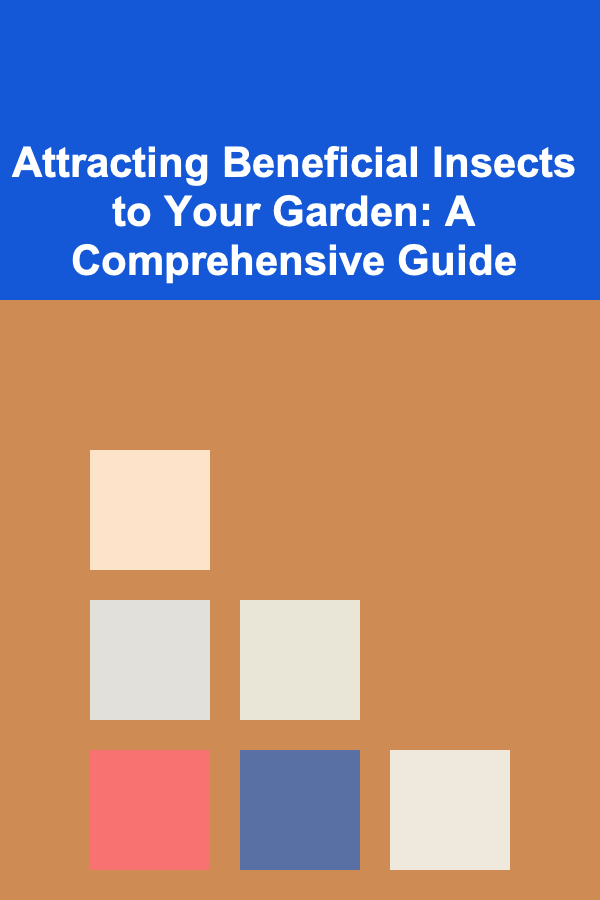
Attracting Beneficial Insects to Your Garden: A Comprehensive Guide
ebook include PDF & Audio bundle (Micro Guide)
$12.99$11.99
Limited Time Offer! Order within the next:

A thriving garden is a delicate ecosystem, a complex web of interactions between plants, soil, and the creatures that inhabit it. While the thought of insects in the garden might conjure images of pests and damage, a healthy garden actually relies heavily on the presence of beneficial insects. These tiny allies play a crucial role in pollination, pest control, and overall soil health. Attracting and retaining these beneficial insects can significantly reduce the need for chemical pesticides and herbicides, creating a more sustainable and productive garden.
Understanding Beneficial Insects
Before diving into the how-to, it's essential to understand what constitutes a "beneficial insect." These aren't just any insects that happen to be in your garden; they are species that provide a specific, positive contribution to the garden ecosystem. Their benefits typically fall into one of two main categories: pollination and predation.
Pollinators
Pollinators are responsible for transferring pollen from the male part of a flower (stamen) to the female part (pistil), enabling fertilization and the production of fruits, vegetables, and seeds. Without pollinators, many of the plants we rely on for food and beauty would cease to exist. Common pollinators include:
- Bees: Honeybees, bumblebees, mason bees, and various solitary bee species are highly efficient pollinators. Different bee species are attracted to different types of flowers.
- Butterflies and Moths: These colorful insects are attracted to nectar-rich flowers and play a significant role in pollinating a wide range of plants.
- Hoverflies (also known as Syrphid Flies): These flies often mimic the appearance of bees and are effective pollinators, especially of smaller flowers.
- Beetles: While sometimes overlooked, certain beetle species are important pollinators, especially for early-blooming plants.
Predators and Parasitoids
These beneficial insects help control populations of harmful pests by preying on them or parasitizing them. Predators directly consume pests, while parasitoids lay their eggs inside or on the pest, eventually killing it as the larvae develop. Some key predators and parasitoids include:
- Ladybugs (Lady Beetles): These are voracious predators of aphids, mealybugs, and other soft-bodied insects.
- Lacewings: Both the larval and adult stages of lacewings are effective predators, feeding on aphids, mites, thrips, and other small pests.
- Praying Mantises: These large, ambush predators consume a wide variety of insects, including grasshoppers, caterpillars, and flies.
- Ground Beetles: These nocturnal predators live in the soil and feed on slugs, snails, cutworms, and other ground-dwelling pests.
- Parasitic Wasps: These tiny wasps lay their eggs inside or on specific pests, such as aphids, caterpillars, and whiteflies. The developing wasp larvae eventually kill the host insect.
- Hoverfly Larvae: As mentioned above, adult hoverflies are pollinators, but their larvae are also predators of aphids.
- Soldier Beetles: These beetles are both pollinators and predators, feeding on aphids and other soft-bodied insects.
Creating a Beneficial Insect Habitat: The Fundamentals
Attracting beneficial insects isn't about simply sprinkling some seeds and hoping for the best. It requires a deliberate and holistic approach to garden design and management. Here are the fundamental principles to keep in mind:
1. Provide a Diversity of Food Sources
Beneficial insects, like all living things, need food to survive. A diverse array of flowering plants that bloom at different times of the year ensures a continuous supply of nectar and pollen for pollinators and other food sources for predators and parasitoids. Consider the following:
- Plant a variety of flowering plants: Choose plants with different flower shapes, sizes, and colors to attract a wider range of beneficial insects. Native plants are particularly valuable, as they are adapted to the local climate and provide the best food source for native insects.
- Include plants with small, clustered flowers: Many beneficial insects have short mouthparts and struggle to access nectar in large, complex flowers. Plants with small, clustered flowers, such as dill, fennel, cilantro, yarrow, and Queen Anne's lace, are excellent choices.
- Provide continuous blooms: Plan your garden to have something blooming from early spring to late fall. Succession planting -- planting new seeds or seedlings every few weeks -- can help extend the bloom season of certain flowers.
- Don't be too tidy: Allow some weeds to flower. Many weeds, such as dandelions and clover, provide valuable nectar and pollen for beneficial insects, especially early in the season when other flowers are scarce. Of course, it's important to manage weeds to prevent them from overwhelming your garden, but a little "untidiness" can be beneficial.
- Consider "insectary strips": These are dedicated areas within your garden specifically designed to attract beneficial insects. Plant a mix of flowering plants known to attract pollinators and predators, and leave the area relatively undisturbed.
2. Offer Shelter and Nesting Sites
Beneficial insects need safe places to rest, hide from predators, and lay their eggs. Providing shelter and nesting sites will encourage them to stay in your garden and build their populations.
- Leave some areas undisturbed: Avoid excessive tilling or mulching, which can disrupt ground-dwelling insects. Leave some areas of bare soil for ground-nesting bees.
- Provide leaf litter and plant debris: Many beneficial insects overwinter in leaf litter and plant debris. Instead of removing all fallen leaves and dead plant material, leave some in protected areas of your garden.
- Build or buy insect hotels: These structures provide artificial nesting sites for solitary bees, lacewings, and other beneficial insects. You can easily build your own insect hotel using natural materials like bamboo, hollow stems, and drilled wood blocks.
- Plant shrubs and trees: These provide shelter and nesting sites for a variety of beneficial insects, as well as offering protection from wind and sun.
- Provide water sources: A shallow dish of water with pebbles or marbles for insects to land on can provide a much-needed source of hydration, especially during hot, dry weather.
3. Minimize Pesticide Use
Pesticides, even those labeled "organic," can be harmful to beneficial insects. Broad-spectrum insecticides kill both pests and beneficial insects indiscriminately, disrupting the delicate balance of the garden ecosystem. Minimizing pesticide use is crucial for attracting and retaining beneficial insects.
- Identify pests correctly: Before reaching for a pesticide, make sure you have correctly identified the pest and understand its life cycle. Many insects are harmless or even beneficial, and treating them with pesticides is unnecessary.
- Use preventative measures: Healthy plants are less susceptible to pests and diseases. Practice good gardening techniques, such as proper watering, fertilization, and crop rotation, to keep your plants strong and resilient.
- Encourage natural pest control: By attracting beneficial insects, you can create a natural system of pest control in your garden.
- Use targeted pesticides only when necessary: If you must use a pesticide, choose a selective one that targets the specific pest you are trying to control, and apply it carefully, following the instructions on the label. Avoid broad-spectrum insecticides that kill beneficial insects as well as pests.
- Consider alternative pest control methods: Explore alternative pest control methods, such as hand-picking pests, using insecticidal soap or horticultural oil, and employing physical barriers like row covers.
4. Practice Good Garden Hygiene
While leaving some plant debris is beneficial, it's also important to maintain good garden hygiene to prevent the spread of diseases and pests. Remove diseased or heavily infested plants promptly, and clean up fallen fruit and vegetables that can attract pests.
- Remove diseased plants: Diseased plants can attract pests and spread disease to healthy plants. Remove and dispose of diseased plants promptly.
- Clean up fallen fruit and vegetables: Fallen fruit and vegetables can attract pests like fruit flies and slugs. Clean up fallen produce regularly to prevent pest problems.
- Weed regularly: Weeds can harbor pests and diseases, and they can compete with your plants for water and nutrients. Weed your garden regularly to keep it healthy.
- Compost properly: Composting is a great way to recycle garden waste, but it's important to compost properly to kill weed seeds and disease pathogens. Make sure your compost pile reaches a high enough temperature to kill these harmful organisms.
Planting for Specific Beneficial Insects
While a diverse garden will attract a variety of beneficial insects, you can further enhance your garden's appeal by planting specific plants that are known to attract certain species. Here are some examples:
Attracting Bees
- Lavender: Bees are drawn to the fragrant flowers of lavender.
- Borage: This herb is a favorite of bumblebees and other long-tongued bees.
- Salvia: Salvia offers a wide range of flower colors and shapes, attracting various bee species.
- Sunflowers: These large, cheerful flowers provide abundant nectar and pollen for bees.
- Clover: Clover is a readily available and attractive food source for many bee species. Consider incorporating it into your lawn or garden beds.
- Bee Balm (Monarda): As the name suggests, bee balm is highly attractive to bees, especially bumblebees.
Attracting Ladybugs
- Dill: Ladybugs are attracted to dill, as well as other members of the carrot family (Apiaceae).
- Fennel: Similar to dill, fennel provides food and shelter for ladybugs.
- Cilantro: Cilantro flowers attract ladybugs and other beneficial insects.
- Yarrow: Yarrow's flat-topped flower clusters provide a landing pad for ladybugs and other small insects.
- Marigolds: While often touted as a general pest deterrent, marigolds can also attract ladybugs, especially French marigolds.
Attracting Lacewings
- Dill: Lacewings are attracted to dill and other members of the carrot family.
- Fennel: Fennel provides food and shelter for lacewings.
- Cosmos: Cosmos flowers attract lacewings and other beneficial insects with their nectar-rich blooms.
- Goldenrod: Goldenrod is a late-blooming perennial that provides a valuable food source for lacewings in the fall.
- Queen Anne's Lace: The umbrella-shaped flowers of Queen Anne's Lace attract a variety of beneficial insects, including lacewings.
Attracting Hoverflies
- Dill: Hoverflies are attracted to dill and other members of the carrot family.
- Fennel: Fennel provides food and shelter for hoverflies.
- Alyssum: Alyssum's small, fragrant flowers are highly attractive to hoverflies.
- Calendula: Calendula flowers attract hoverflies and other beneficial insects.
- Yarrow: Yarrow's flat-topped flower clusters provide a landing pad for hoverflies and other small insects.
Specific Strategies for Enhancing Beneficial Insect Populations
Beyond providing food and shelter, there are specific strategies you can employ to further enhance beneficial insect populations in your garden.
Companion Planting
Companion planting involves strategically planting different species together to benefit each other. Some companion plants attract beneficial insects, while others repel pests or improve soil health. For example:
- Basil planted near tomatoes: Basil is believed to repel tomato hornworms and attract pollinators.
- Marigolds planted near vegetables: Marigolds are thought to repel nematodes and other soil pests.
- Nasturtiums planted as a trap crop: Nasturtiums attract aphids, diverting them from other plants in your garden.
Crop Rotation
Crop rotation involves rotating the location of different crops each year. This helps to prevent the buildup of pests and diseases in the soil and can also improve soil fertility. Crop rotation can also benefit beneficial insect populations by providing a more diverse food source.
Using Cover Crops
Cover crops are plants grown primarily to protect and improve the soil. They can also provide habitat and food for beneficial insects. For example, buckwheat is a fast-growing cover crop that attracts pollinators, while hairy vetch can help to improve soil nitrogen and provide shelter for ground beetles.
Introducing Beneficial Insects
In some cases, you may choose to purchase and release beneficial insects into your garden. This can be a helpful strategy for controlling specific pests, but it's important to consider the following:
- Purchase from a reputable source: Make sure you are buying healthy, viable insects from a reputable supplier.
- Release at the right time: Release beneficial insects at the appropriate time of year and under the right weather conditions.
- Provide appropriate habitat: Make sure your garden provides the necessary food and shelter for the released insects to survive and thrive.
- Don't rely solely on purchased insects: Attracting and retaining native beneficial insects is a more sustainable long-term solution.
Monitoring and Evaluation
Once you've implemented strategies to attract beneficial insects, it's important to monitor your garden to assess their effectiveness. Keep an eye out for:
- Increased pollinator activity: Are you seeing more bees, butterflies, and other pollinators visiting your flowers?
- Reduced pest populations: Are you noticing fewer pests on your plants?
- Increased presence of beneficial insects: Are you seeing more ladybugs, lacewings, and other beneficial insects in your garden?
Keep records of your observations and adjust your strategies as needed. Gardening is an ongoing learning process, and by paying attention to the interactions between plants, pests, and beneficial insects, you can create a healthy, thriving ecosystem in your backyard.
Conclusion
Attracting beneficial insects to your garden is an investment in its long-term health and productivity. By providing food, shelter, and a pesticide-free environment, you can create a welcoming habitat for these tiny allies and reap the rewards of a more sustainable and bountiful garden. Embrace the principles of biodiversity, observation, and continuous learning, and you'll be well on your way to creating a thriving ecosystem that supports both plants and pollinators.

How to Choose the Right Office Supplies for Maximum Efficiency
Read More
How to Create a Family-Friendly DIY Home Escape Room
Read More
How to Maintain Your Home's Concrete Driveway for Durability
Read More
How to Navigate Financial Challenges During Economic Uncertainty
Read More
How to Stage Your Home When You Have Minimal Furniture
Read More
How to Consolidate Your Debt
Read MoreOther Products

How to Choose the Right Office Supplies for Maximum Efficiency
Read More
How to Create a Family-Friendly DIY Home Escape Room
Read More
How to Maintain Your Home's Concrete Driveway for Durability
Read More
How to Navigate Financial Challenges During Economic Uncertainty
Read More
How to Stage Your Home When You Have Minimal Furniture
Read More